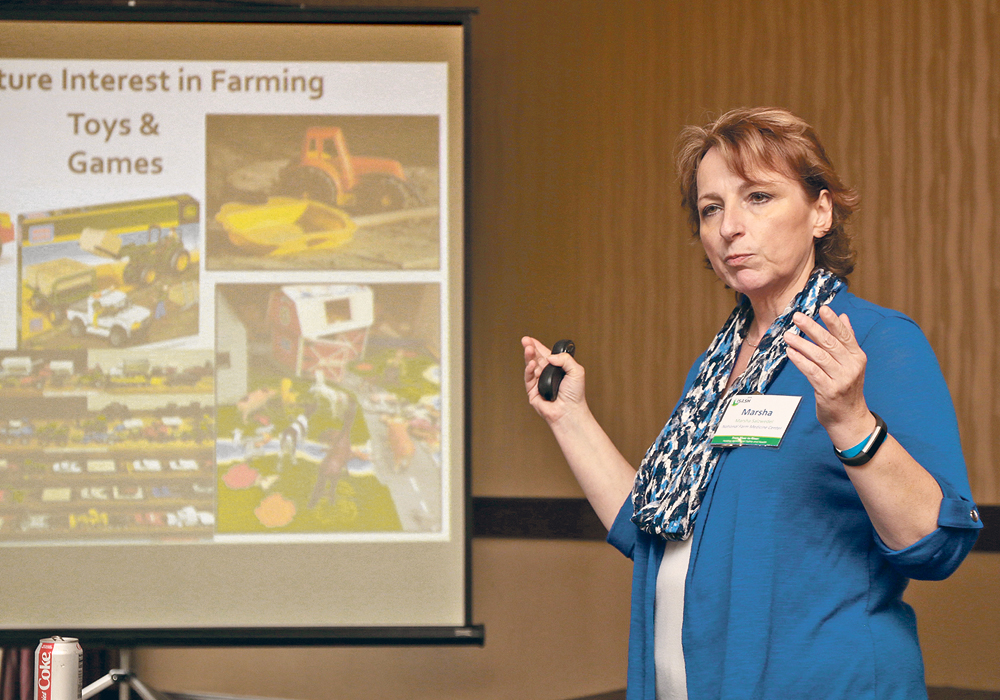The National Children’s Center recommends the following initiatives:
DES MOINES, Iowa — Safety advocates are continuing to push for changes that aim to reduce danger for children on farms, citing statistics that show little improvement.
Speaking during a recent child safety conference in Des Moines, agricultural youth safety specialist Marsha Salzwedel said evidence suggests child death numbers remain unchanged even though injuries have dropped.
“Injury numbers have gone down, so we know that hopefully that’s due to some of the work we are doing,” said Salzwedel of the National Children’s Center for Rural and Agricultural Health and Safety during the Child Agricultural Injury Prevention workshop.
Read Also

Farming Smarter receives financial boost from Alberta government for potato research
Farming Smarter near Lethbridge got a boost to its research equipment, thanks to the Alberta government’s increase in funding for research associations.
“Unfortunately on the flip side of that, evidence suggests we are not seeing the reduction in fatalities.”
Statistics compiled in the United States show that the fatality rate in 2015 among youth workers was 28 per 100,000 full-time equivalents.
In Canada, nearly 250 children younger than 15 were killed in farming incidents between 1990 and 2009, according to the Canadian Agricultural Injury Report.
Safety experts estimate a child dies in an agriculture-related incident every three days in the United States, and about 33 children are injured from farming incidents every day.
Most child farm deaths are caused by tractors. Motor vehicles, like ATVs and skid steers, as well as drowning or grain engulfment hazards are also commonly fatal.
“We need to do better,” Salzwedel said.
She said a key challenge is getting farmers to implement measures to improve safety.
In many cases, she said, parents or supervisors underestimate injury risks, don’t realize it could happen to their families or they might lack trust in health and safety professionals.
“They might say that safety is obvious and common sense, but they don’t always model safety behaviours,” Salzwedel said.
“Growing up on a farm, before I entered this job, we as a family didn’t realize what the problems were. For a lot of farmers, we have this tendency to think this happens to other people or that safety is common sense, but injury and death incidents are relatively common.”
To get more farmers on board, she said experts need to build trust with communities, providing practical solutions to their problems.
“We need solutions that are credible and something farmers can use,” she said. “It has to be practical, with the backing of scientific-based evidence.”
But it’ll take more than just convincing farmers to implement practical safety measures.
Salzwedel said education of legislators must improve to create innovative solutions.
For example, she said, child care in rural areas is hard to find and costly for farm workers.
But if child care could be written off as an expense, similar to health care, then it could be more attainable for families, meaning their kids wouldn’t end up in the fields with them.
“There are innovative solutions like that, but we need to educate our legislators and the public about them.”
She said addressing safety for the anabaptist and migrant worker populations is particularly of focus.
The anabaptist community is heavily agrarian, with children often working on the farm, she said, while migrant workers also see their children on farm sites, due to lack of available child care.
Dee Jepsen, an associate professor with Ohio State University, who works with anabaptist communities, said even though their farm environments are unique, their challenges are similar to non-anabaptist farmers.
She said practical solutions are key no matter which community she’s working in.
“I appreciate working with practical issues in their community, rather than imposing on them from the external word,” she said.
“Yes, farmers need external assistance, but they identify what they need and where they need help.”
Top safety strategies
The National Children’s Center recommends the following initiatives:
- Keep kids away from tractors.
- Tractors cause more than 40 percent of accidental farm deaths of children under 15. Four out of five farm children regularly ride tractors.
- Keep young children out of the worksite.
- ATVs and skid steers are equipment hazards.
- Supervision is key when children are working in and around grain, and with animals.
- Develop a safe play area on the farm.
- Ensure work is age appropriate.
- Teens can lack experience, ask few questions, are generally impulsive and like to take risks. Parents should look at work guidelines for youth at www.cultivatesafety.org/work.
- Ensure environment is as safe as possible.
- Eliminate distractions, like cellphones, slippery and uneven surfaces, and repetitive motions. Provide protective equipment to children such as non-skid shoes, gloves and hearing protection.
- Provide training for work and tasks, and ensure proficiency.
- Model safe behaviours, train youth, practise until proficient and supervise.


















